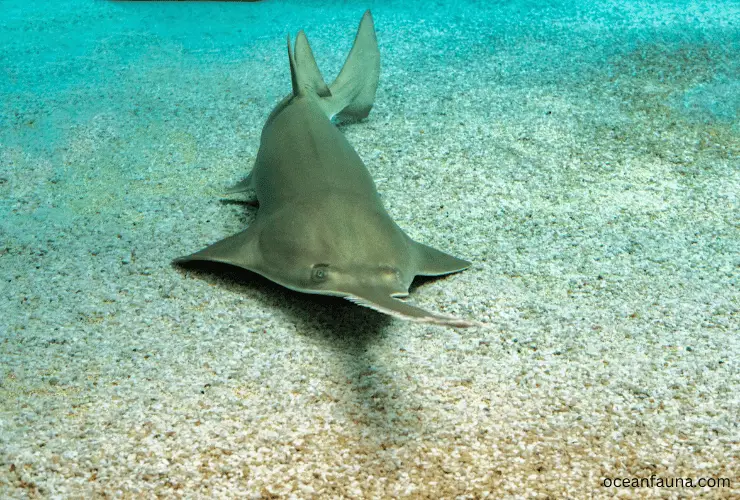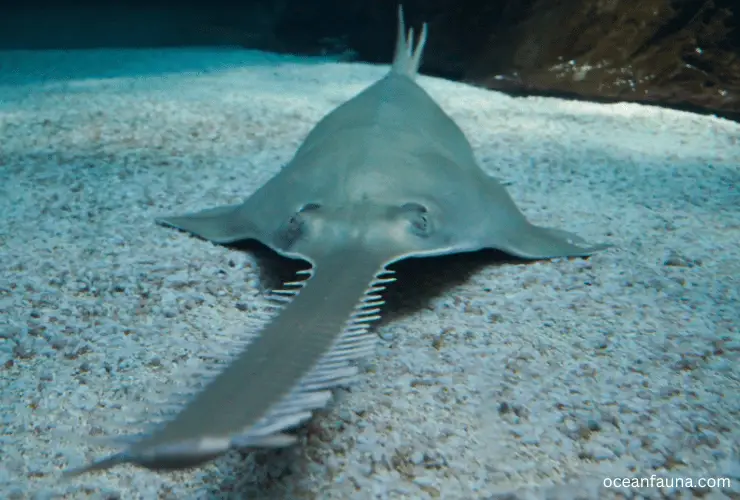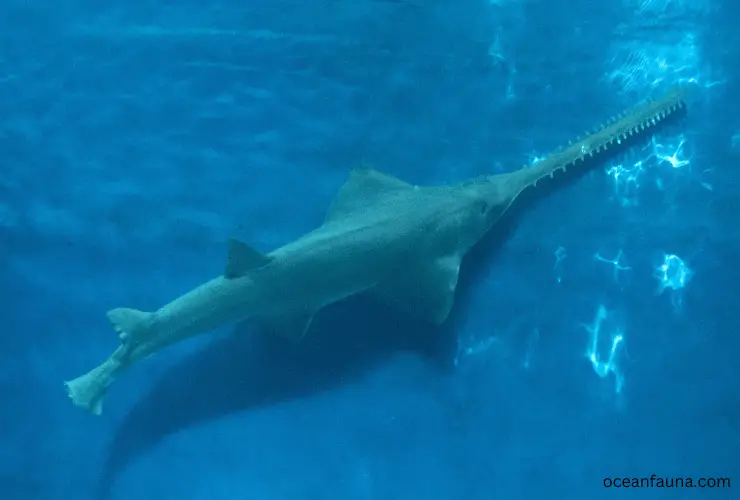Yes, the ocean is home to many mysterious and majestic creatures, like sawfish. These ancient fish are now endangered, so let’s examine why this species has declined so significantly in just the last few decades.
Sawfish, among the most iconic ocean creatures, have been on the endangered species list since 2003 due to human interference with their habitats. Do you want to know more about this creature and its existence: Extinct or endangered? Stay with me till the end of this guide to discover the mystery.
About Sawfish and Its Existence: Yes, Not Extinct
These fascinating creatures inhabit coastal waters in Australia, Asia, and Africa but can be found as far away as Central America. They are an important part of the food chain and play a vital role in maintaining healthy ecosystems by keeping things like fish populations balanced.
While conservation efforts have been ongoing for years, sawfish still face many dangers from wildlife and humans.

Due to poachers hunting them for their fins, the loss of wetlands from pollution and development projects, overfishing within their habitat, and changes to the climate patterns that affect their spawning success and migration routes — sawfish numbers continue to drop.
As such, it is increasingly more urgent now than ever before to protect these unique creatures in order for them to survive and thrive in our oceans into the future.
How Rare Is It to See a Sawfish?
Sawfish are a rare and awe-inspiring species, so not surprisingly, they are becoming more difficult to encounter in the wild. With their long saw-like snouts and flat bodies, these mysterious creatures’ movements are sometimes mistaken for that of a shark.
But in contrast to sharks, who have had millennia of evolution to perfect their behavior and swimming ability, the sawfish’s unique design is relatively new on the evolutionary scale.
Unfortunately, this makes them even more vulnerable to human interference, such as fishing vessels and environmentally damaging human activity.
As a result, spotting sawfish in nature is becoming increasingly rare – it can be difficult to distinguish them from other larger fish, and they often bury underneath the sediment of rivers and coastal ocean floors.
If you ever have the opportunity to see one of these fascinating animals in person, then consider yourself very lucky – witnessing such an incredibly rare event doesn’t happen very often!
Are Sawfish an Endangered Species?
Sawfish, a unique species of ray found in shallow coastal waters, is considered endangered in many parts of the world. Despite their bony snouts resembling a chainsaw, they are composed of electro-sensory organs that help the sawfish detect their prey.
Unfortunately, this impressive feature has also made them victims of overfishing out of curiosity or just for their fins.
The alarming population decline has been exacerbated by unsustainable practices such as habitat destruction and indiscriminate fishing, so proactive efforts need to be taken now to protect these majestic creatures from extinction.
Existing marine protected areas and strict catchment limits should be monitored and updated if necessary to ensure that dwindling numbers can recover and flourish.
Are Smalltooth Sawfish Endangered?
Smalltooth sawfish are a subspecies of the family Pristidae and part of an ancient lineage of rays that dates back over 200 million years.
Sadly, this iconic species is classed as ‘Critically Endangered’ by the International Union for Conservation of Nature.
They have experienced a drastic decline in numbers due to over-harvesting and unintentional capture in fishing gear.
In addition, habitat loss due to dredging and coastal development has contributed to their endangered status. Smalltooth Sawfish face the danger of extinction due to low reproductive potential.
Organizations such as the National Geographic Society are working hard through education and increased public awareness to protect these animals and their dwindling habitats, ensuring they don’t disappear forever.
Are Largetooth Sawfish Endangered? Why Are They Endangered?
Largetooth sawfish are classified as critically endangered by the International Union for Conservation of Nature (IUCN), largely due to their unique and attractive morphology.
The main cause for their tremendous decline in numbers is overfishing; they were once a popular catch due to the size of the highly prized saw-like structure on its head.
Despite legal protection since 2003, which prohibits taking and selling these marine creatures, they continue to be caught both intentionally and unintentionally due to their shallow water habitat.
Other threats include habitat loss due to dams blocking migration routes, coastal development, pollution by organic matter, and nutrient overloads and pharmaceutical products. For these reasons, conservation efforts are urgent to protect this species from extinction.
Why Is the Sawfish Endangered?
The sawfish is a unique species of fish that encounters various risks to its survival, leading to its endangerment status today. Its long snout, easily recognizable amongst other sea creatures, has become particularly vulnerable due to the practice of recreational fishing.

Without the ability to control their own movements and speed, they can become hooked in angling lines – often resulting in them being killed or seriously injured.
As well as being targets for sport anglers, sawfish have suffered habitat loss due to dams and mangrove clearance and overfishing, which has been particularly damaging because they are slow to reach sexual maturity.
All these issues, combined with minimal conservation efforts, put their future at risk. Protecting the remaining populations and restoring habitat where possible is essential for this species survival.
Why Are Dwarf Sawfish Endangered?
Dwarf sawfish are facing local extinction in multiple areas due to major threats to their population. Incidental catches in commercial fishing, entanglement in nets, loss of habitat, and water pollution drive the dwarf sawfish closer toward vulnerable and endangered species status.
Addressing these threats is critical for preserving this rare species and its habitats. The International Union for Conservation of Nature listed the dwarf sawfish as endangered due to its continuous population decline in various parts of the world.
Awareness campaigns and conservation efforts are necessary to help reverse the trend and prevent species from heading toward local extinction.
How Many Sawfish Are Left in The World?
Sadly, sawfish populations have been dramatically reduced in the past few decades.
The International Union for Conservation of Nature lists three species as Critically Endangered, three as Endangered, and two as Vulnerable – this puts eight out of ten sawfish species in danger of extinction ~(source).
Scientists estimate that the global population has shrunk by more than 80% over the last century due to overfishing, habitat loss, entanglement in fishing gear, and other human activities. This means fewer than 10,000 individuals may remain on Earth today.
In some areas, declines have been even more severe: the large-tooth sawfish could be down to fewer than 200 mature individuals.
Conservation efforts are underway worldwide to protect key spawning sites and reduce fishing pressure so that some populations can recover over time – but at current rates, it may still be too late for many of these majestic fish species.
How Many Sawfish Will Be Left In 2022?
It is difficult to get an exact number of how many sawfish will remain in 2022, but it is clear that their numbers are dropping at an alarming rate.
Due to overfishing and damaging habitats, sawfish populations have been severely depleted throughout the world’s oceans.
In fact, a recent assessment by the International Union for Conservation of Nature (IUCN) estimates that about two-thirds of the species are facing extinction ~(Source).
Therefore, conservation efforts such as fisheries regulation and protection for critical habitat areas must be increased to save the remaining sawfish from disappearing forever. While these measures may not bring the numbers back up to their former glory, they are our only hope for keeping this majestic fish from going extinct.
Frequently Asked Questions (FAQS)
Can you own a sawfish?
No, it is illegal to own a sawfish in most places. They are protected from harvest and trade in most countries worldwide due to their endangered status. It is also important to remember that every country has different laws regarding wildlife ownership.
Are sawfish endangered in Florida?
Yes, all sawfish species are listed as endangered in Florida. The population of the Smalltooth Sawfish (the only sawfish found in the state) is still decreasing, and there are severe restrictions on harvest and fishing activities to help protect them.
Is it legal to buy and sell sawfish in the US?
No, it is illegal to buy or sell sawfish saws in the United States. All species of sawfish are listed as endangered and therefore protected from commercial harvest and trade.
Why can’t you remove a sawfish from the water?
Removing a sawfish from the water is illegal because they are on the endangered species list. Removing them could cause further harm and injury and disrupt their natural habitat.
What is the lifespan of a sawfish?
The average lifespan of sawfish is between 15 and 20 years. However, some individuals may live as long as 50 years in the wild with proper care and protection.
Conclusion
After looking at the evidence, it is clear that sawfish are endangered creatures that need our help. There are many threats to their survival, and without immediate and continuing conservation efforts, they risk being pushed to extinction.
Thankfully, through various species recovery plans, public education campaigns, and partnerships between governments and non-governmental organizations, we hope to save these remarkable animals.
We all need to do our part in supporting the efforts of those on the ground who ensure sawfish populations remain healthy throughout future generations. Moving forward, let’s continue to work together in protecting these remarkable creatures so their future is brighter than ever before!

